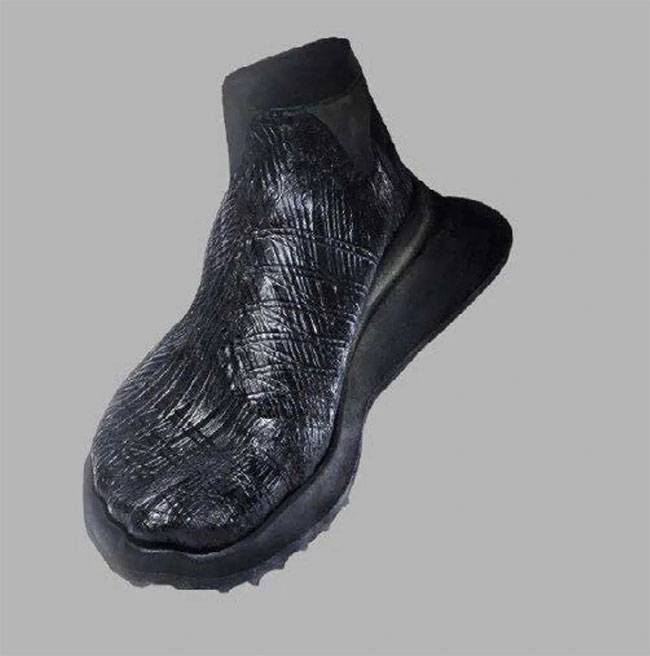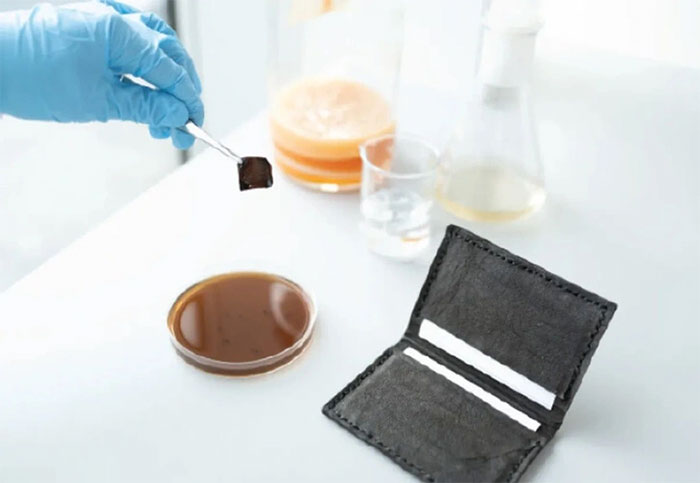Successfully made shoes and leather wallets from... bacteria
British researchers have successfully genetically modified Komagataeibacter bacteria to create a "vegan" leather that is plastic-free and has the ability to self-dye black.
Like many other materials used in the fashion industry, leather and its dyeing process - especially black dyeing - negatively impacts the environment. Therefore, a group of scientists from Imperial College London (Imperial College London) genetically edited a type of Komagataeibacter bacteria to create bacterial cellulose (BC) capable of self-dying black.

The shoe (except the sole) is made from gene-edited Komagataeibacter bacteria - (Photo: Imperial College London).
BC is a promising sustainable leather alternative due to its properties, low infrastructure needs, and biodegradability. Gene-edited Komagataeibacter can produce the enzyme tyrosinase, which helps form black pigment.
To demonstrate the potential of the new method, the team created a black shoe (minus the sole) from gene-edited bacteria in just 2 weeks. The team implanted BC into a shoe mold using gene-edited bacteria, and the resulting shoe was black.
The research team also created a black wallet by cutting and sewing BC sheets secreted by bacteria, according to IFLScience .

BC material capable of self-dying is made into leather wallets - (Photo: Imperial College London).
Growing BC requires a fraction of the carbon emissions, water, land and time compared to raising cows for leather. Unlike plastic-based alternatives, BC can be made without petrochemicals and will biodegrade safely and non-toxically in the environment.
"Inventing a new, faster method to produce sustainable self-dyed vegan leathers is a major achievement for synthetic biology and sustainable fashion ," said Professor Tom Ellis, one of the authors. research, said.
The research team is continuing to be able to create self-dying BCs with other colors, such as synthetic indigo from certain strains of E. coli.
The research was published in the journal Nature Biotechnology.
- The fungi and bacteria that follow shoes enter the house
- A 2,000-year-old Roman shoe resembles modern sports shoes
- Unbelievably dangerous when wearing shoes into the house
- Unbelievable special skin made entirely from ... mushrooms!
- Can you get a blood infection when you try on shoes but not all?
- Amazing shocking about super soft leather for golf gloves
- Biodegradable shoes
- New fake leather made from mushrooms growing on old bread
- Engineer chemical treatment of coffee grounds as shoe material
- Development of artificial skin from mushrooms that looks like real leather
- New shoes: Just go, just charge the battery
- American students successfully built power generation shoes
 Why do potatoes have eyes?
Why do potatoes have eyes? 'Tragedy' the world's largest carnivorous life: Death becomes ... public toilet
'Tragedy' the world's largest carnivorous life: Death becomes ... public toilet Tomatoes were once considered 'poisonous' for 200 years
Tomatoes were once considered 'poisonous' for 200 years Detecting microscopic parasites on human face
Detecting microscopic parasites on human face Black holes create mysterious swirling 'structures' that could open 'gateways' into dark matter
Black holes create mysterious swirling 'structures' that could open 'gateways' into dark matter  Surprising facts about the black panther - the inspiration for the character Black Panther
Surprising facts about the black panther - the inspiration for the character Black Panther  The nearest black hole discovered is only 150 light years from Earth
The nearest black hole discovered is only 150 light years from Earth  New discovery of the oldest black hole in the universe
New discovery of the oldest black hole in the universe  The Black Pyramid and the tragedy of deep oblivion: A thousand years later, still no escape from the tragedy of tomb raiding
The Black Pyramid and the tragedy of deep oblivion: A thousand years later, still no escape from the tragedy of tomb raiding  Exploring the 'Black Box of the Earth' project: A device that records the process of human extinction
Exploring the 'Black Box of the Earth' project: A device that records the process of human extinction 